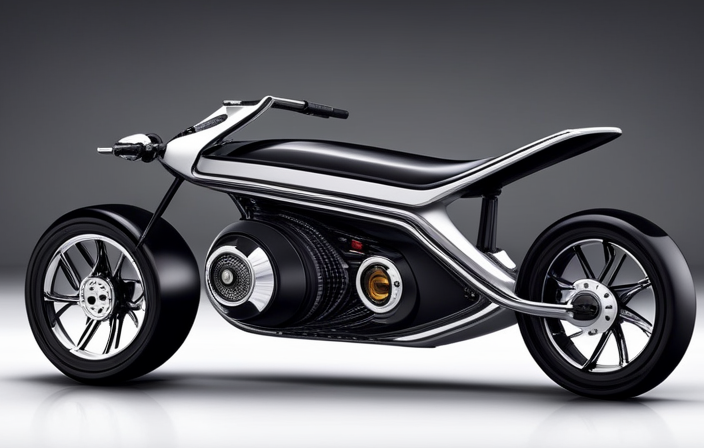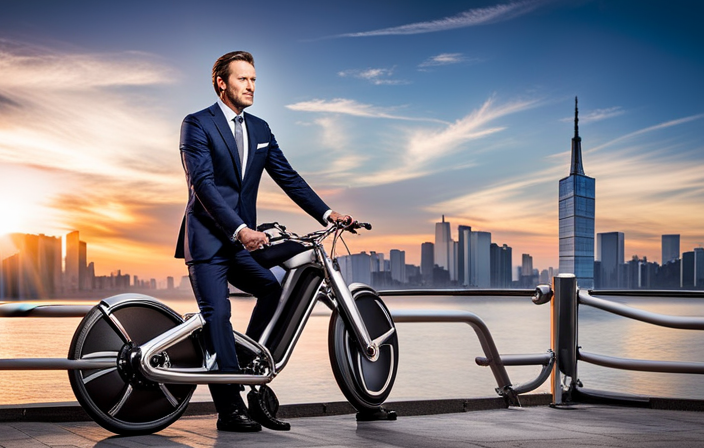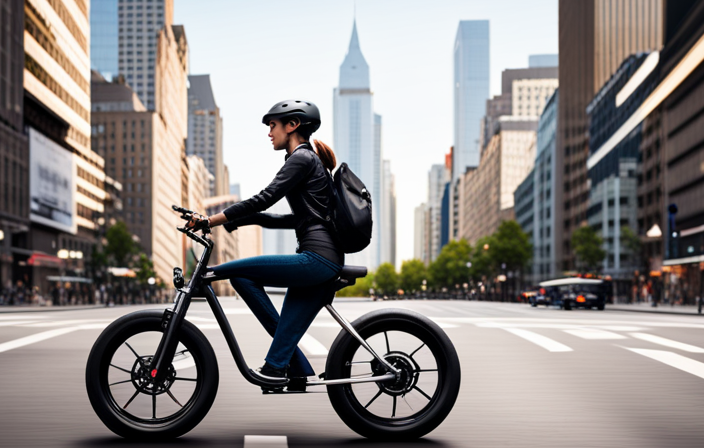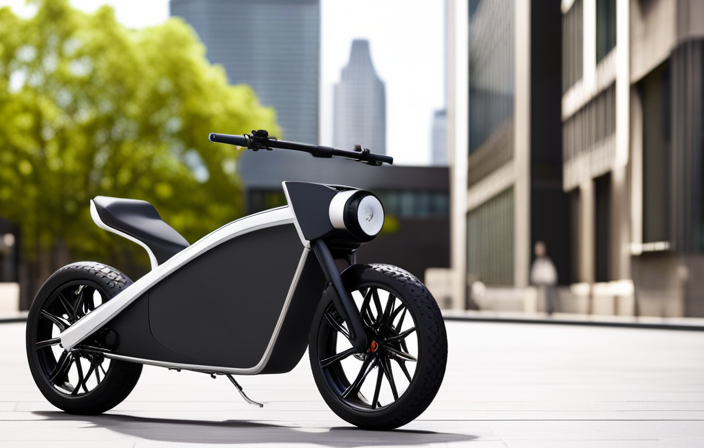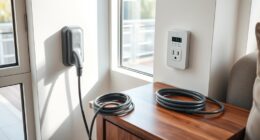As a passionate mini bike enthusiast, I’ve always been fascinated by the inner workings of electric controllers and how they enhance the performance of these compact machines.
Imagine having the power to regulate speed and control acceleration with just a flick of a switch.
In this article, we’ll delve into the world of electric controllers for mini bikes, exploring their components, functionality, and the exciting future developments in this technology.
So, let’s strap on our helmets and dive into the electrifying world of mini bike power!
Key Takeaways
- The electric controller on a mini bike consists of various components such as a power input, motor output, microcontroller unit, and power stage.
- Regular maintenance and protection of the electric controller are important for optimal power output and efficient power and speed control.
- The control circuit components, including the throttle, speed controller, relay, and power regulation components, play a crucial role in controlling the mini bike’s speed and power output.
- The power circuit manages the electricity flow from the battery to the motor, ensuring safe power supply and enabling precise motor control for smooth acceleration, deceleration, and speed regulation.
Understanding Electric Controllers
To understand how an electric controller works on a mini bike, you’ll need to know its main components and their functions.
The electric controller is responsible for regulating voltage and controlling the motor’s speed and direction. It utilizes motor control algorithms to ensure smooth and efficient operation.
The main components of an electric controller include the power input, which receives the electrical energy from the battery, and the motor output, which delivers the power to the motor.
Additionally, the controller has a microcontroller unit (MCU) that processes signals from the throttle and other sensors to determine the desired motor speed and direction. It also includes a power stage, which consists of transistors that control the current flow to the motor.
Understanding these components and their functions is crucial in comprehending the basics of mini bike power and speed control.
The Basics of Mini Bike Power and Speed Control
Understanding the basics of power and speed control is essential for operating a mini bike. The electric controller plays a crucial role in regulating these functions. To optimize power output, regular maintenance of the electric controller is necessary.
This involves checking for any loose connections, cleaning the contacts, and ensuring that the wiring is intact. It is also important to keep the controller protected from moisture and extreme temperatures.
By maintaining the electric controller, you can ensure that it functions efficiently, allowing for optimal power and speed control on your mini bike.
Now, let’s delve into the components of an electric controller, which further contribute to its functionality and performance.
Components of an Electric Controller
In discussing the components of an electric controller, we will delve into the intricacies of the control circuit, power circuit, and input and output devices.
The control circuit serves as the brain of the controller, regulating the flow of electricity and dictating the behavior of the power circuit.
The power circuit, on the other hand, is responsible for delivering the necessary power to the various components of the system, ensuring smooth functionality.
Lastly, the input and output devices allow for communication between the controller and the user, enabling the control and monitoring of the mini bike’s power and speed.
Control Circuit
You can easily understand how an electric controller works on a mini bike by examining the control circuit. The control circuit is responsible for regulating the power that flows to the motor and other components of the mini bike.
Here are the key components of the control circuit:
-
Throttle: The throttle is connected to the control circuit and allows the rider to control the speed of the mini bike. By adjusting the throttle, the rider can increase or decrease the power sent to the motor.
-
Speed controller: The speed controller is the brain of the control circuit. It receives signals from the throttle and adjusts the power output accordingly. It ensures that the power sent to the motor is regulated and consistent.
-
Relay: The relay is an electromagnetic switch that controls the flow of power to the motor. It is activated by the speed controller and allows the motor to receive the appropriate amount of power.
-
Power regulation: The control circuit also includes components for power regulation, such as voltage regulators and current limiters. These components ensure that the power supplied to the motor is within safe limits, preventing damage to the motor or other components.
By understanding the control circuit, you can gain insight into how an electric controller on a mini bike operates.
Now let’s dive into the power circuit, which is responsible for delivering the power to the motor.
Power Circuit
Now, let’s take a look at how the power circuit delivers electricity to the motor.
The power circuit is an essential component of the electric controller as it is responsible for managing the flow of electricity from the battery to the motor. It ensures that the motor receives the appropriate amount of power for efficient operation.
The power circuit consists of various components such as relays, fuses, and switches that work together to control the flow of current. These components protect the motor from excessive current and voltage fluctuations, ensuring its longevity and safe operation.
By effectively managing power, the power circuit enables precise motor control, allowing for smooth acceleration, deceleration, and speed regulation. With the power circuit in place, the motor can perform optimally and efficiently.
Moving on to the next section, let’s explore the input and output devices utilized in the electric controller.
Input and Output Devices
Take a moment to consider the various input and output devices used in the electric controller.
Input devices are essential for the controller to receive signals and information from the rider. These can include a throttle, brake sensors, and even a key switch for power activation.
On the other hand, output devices are responsible for translating these input signals into actions. Common output devices found in electric controllers include relays, motor drivers, and LED indicators.
These devices work together to control the power flow and ensure the mini bike operates smoothly.
Now, let’s delve into how an electric controller regulates power, ensuring optimal performance and safety for the rider.
How an Electric Controller Regulates Power
The electric controller regulates the power flow to ensure optimal performance on the mini bike. It accomplishes this by carefully controlling the voltage that is supplied to the various components of the bike. There are several power regulation techniques used by the controller, including pulse width modulation (PWM) and voltage regulation. These techniques allow for precise control over the amount of power delivered to the motor and other electronic components.
By regulating the voltage, the controller prevents overloading and ensures that the bike operates efficiently. Additionally, the controller monitors the power consumption of the bike and adjusts the power flow accordingly, maximizing battery life and overall performance.
With its sophisticated power regulation capabilities, the electric controller plays a crucial role in the smooth operation of the mini bike.
Moving on to the role of sensors in electric controllers…
Role of Sensors in Electric Controllers
In the discussion on the role of sensors in electric controllers, we will explore two key points: speed sensors and current sensors.
Speed sensors play a crucial role in measuring the rotational speed of the motor, allowing the controller to adjust power output accordingly.
Current sensors, on the other hand, monitor the flow of current through the system, ensuring that the controller can regulate power and protect against overloading.
Together, these sensors enable precise control and efficient operation of the electric controller.
Speed Sensors
To better understand how an electric controller works on your mini bike, you’ll need to know about speed sensors. Speed sensors play a crucial role in the speed control and power regulation of the mini bike. These sensors measure the rotational speed of the motor shaft and provide the necessary feedback to the controller. By continuously monitoring the speed, the controller can adjust the power output to maintain a desired speed.
Here is a table that provides an overview of the speed sensors commonly used in electric controllers:
| Sensor Type | Working Principle |
|---|---|
| Hall Effect Sensor | Detects changes in magnetic field to determine speed |
| Optical Sensor | Uses a light source and a receiver to measure speed |
| Inductive Sensor | Measures the changes in magnetic field caused by the rotating shaft |
With the help of these speed sensors, the electric controller can accurately regulate the power output to ensure a smooth and controlled riding experience.
Moving on to the next section about current sensors, we will explore how they contribute to the overall functionality of the electric controller without interrupting the flow of power.
Current Sensors
Moving on, current sensors are essential components that measure the electrical current flowing through the system, allowing the controller to accurately adjust the power output. They play a crucial role in ensuring efficient operation and preventing any potential damage to the electric controller.
Here are three key points to consider regarding current sensors:
-
Current measurement: These sensors provide real-time data on the amount of current passing through the system. This information is crucial for monitoring and controlling the power flow, ensuring optimal performance and preventing overloading.
-
Power regulation: By accurately measuring the current, the controller can adjust the power output accordingly. This allows for precise control and regulation of the system, ensuring that the desired power levels are maintained consistently.
-
Safety: Current sensors also contribute to the safety of the electric controller by detecting any abnormal current levels. In case of a fault or short circuit, the sensors can trigger protective measures to prevent further damage or potential hazards.
With current sensors in place, the electric controller can effectively manage the power flow and ensure safe and efficient operation. Now, let’s explore the safety features in electric controllers.
Safety Features in Electric Controllers
Make sure you understand the safety features of electric controllers on mini bikes. These features are crucial for regulatory compliance and ensuring the rider’s safety.
One important safety feature is the emergency shut off, which allows the rider to quickly stop the bike in case of an emergency. This feature is typically activated by a button or switch that cuts off power to the motor.
In addition to the emergency shut off, electric controllers also often have built-in safety measures such as overcurrent protection and thermal overload protection. These features help prevent damage to the controller and ensure safe operation.
Understanding and utilizing these safety features is essential for a safe and enjoyable riding experience.
Now, let’s move on to discussing the different types of electric controllers available for mini bikes.
Types of Electric Controllers
There are various types of electric controllers available for mini bikes. The type of motor and desired performance of the bike will determine the most suitable controller.
The most common types of controllers include brushed controllers, brushless controllers, and programmable controllers. Brushed controllers are simple and cost-effective, suitable for basic mini bikes. Brushless controllers, on the other hand, offer more advanced features like regenerative braking and smooth acceleration. Programmable controllers are the most versatile, allowing customization of motor settings and performance parameters.
The functions of an electric controller include regulating the flow of electrical current to the motor, controlling speed and torque, and providing safety features like overheat protection and short circuit prevention.
Now that we understand the types and functions of electric controllers, let’s move on to the installation and wiring process.
Installation and Wiring of Electric Controllers
To install and wire the electric controller, you’ll need to follow a specific set of instructions provided by the manufacturer. Begin by gathering all the necessary tools and materials, including the electric controller itself, wiring harness, connectors, and zip ties. Carefully read through the instructions to familiarize yourself with the process.
Start by disconnecting the battery and ensuring the power is off. Locate the appropriate mounting location for the controller on the mini bike, ensuring it is secure and protected from the elements.
Next, follow the wiring diagram provided, connecting each wire to its corresponding terminal on the controller. Double-check all connections for accuracy and tighten any loose connections. Once the wiring is complete, secure the wires using zip ties to prevent any movement or damage.
Now, you are ready to transition into troubleshooting common issues with electric controllers.
Troubleshooting Common Issues with Electric Controllers
One common issue with electric controllers is that they may not function properly due to loose or faulty connections. Troubleshooting techniques can help identify and resolve these common issues.
When troubleshooting electric controllers, it is important to check for the following:
-
Loose wiring connections: Ensure that all the wires are securely connected to their respective terminals. Loose connections can cause intermittent or no power supply, resulting in controller malfunction.
-
Faulty connectors: Inspect the connectors for any signs of damage or corrosion. Faulty connectors can disrupt the flow of electricity and affect the controller’s performance.
-
Overheating: Excessive heat can damage the controller components. Check for proper ventilation and cooling to prevent overheating issues.
By addressing these common issues, you can ensure that your electric controller operates smoothly.
Now, let’s explore how enhancing performance with advanced electric controllers can take your mini bike to the next level.
Enhancing Performance with Advanced Electric Controllers
When it comes to enhancing performance with advanced electric controllers, two key points to consider are adjustable power settings and regenerative braking.
Adjustable power settings allow for fine-tuning the power output of the electric controller, giving the rider more control over the acceleration and speed of the vehicle.
On the other hand, regenerative braking is a feature that allows the electric controller to convert kinetic energy back into electrical energy, which can then be stored in the battery for later use. This improves overall efficiency and extends the range of the vehicle.
Adjustable Power Settings
You can easily adjust the power settings on your mini bike’s electric controller. By optimizing the power settings, you can enhance the performance of your mini bike.
Here are five key benefits of adjustable power settings:
-
Increased acceleration: With higher power settings, your mini bike can accelerate faster, allowing for quick bursts of speed.
-
Improved top speed: Adjusting the power settings can help you reach higher top speeds, giving you a thrilling riding experience.
-
Longer battery life: By finding the optimal power setting, you can extend the battery life of your mini bike, allowing for longer rides.
-
Customizable riding experience: With adjustable power settings, you can personalize the riding experience to match your preferences and skill level.
-
Enhanced control: Fine-tuning the power settings enables better control over your mini bike, ensuring a smooth and precise ride.
Now, let’s delve into the next topic: regenerative braking, which further enhances the efficiency of your mini bike.
Regenerative Braking
Regenerative braking helps to maximize the efficiency of your mini bike by converting kinetic energy into electrical energy. This innovative technology allows the bike to recover energy that is normally lost during braking and store it in the battery for later use.
It offers several benefits, such as increased range, extended battery life, and reduced wear on the mechanical braking system. However, regenerative braking does have its limitations. It may not be as effective at low speeds or when the battery is fully charged. Additionally, the amount of energy that can be recovered depends on factors such as the weight of the rider and the terrain.
Despite these limitations, regenerative braking remains a valuable feature for mini bikes, providing a more efficient and sustainable ride experience.
Speaking of efficiency, let’s now move on to discussing maintenance and care for electric controllers.
Maintenance and Care for Electric Controllers
When it comes to maintaining the electric controller on my mini bike, there are two key points that I always prioritize.
First, I focus on cleaning and inspecting the controller. Regular cleaning is essential to ensure optimal performance. I remove any dirt, dust, or debris that may have accumulated, as these can affect the controller’s functionality. During the cleaning process, I also inspect the controller for any signs of wear or damage. This allows me to address any issues before they worsen and potentially cause further damage.
Second, I make it a point to regularly update the firmware. Keeping the firmware up to date is crucial as it not only improves the controller’s functionality but also enhances its overall efficiency and safety. Firmware updates often include bug fixes, performance enhancements, and new features that can enhance the riding experience.
Cleaning and Inspecting the Controller
To clean and inspect the controller, start by disconnecting the battery and removing any dirt or debris.
Cleaning techniques for the controller include using a soft cloth or brush to gently wipe away any dust or grime. Be careful not to use any liquid cleaners as they can damage the sensitive electronic components.
Inspect the controller for any signs of damage, such as loose wires or burnt-out components. Common issues with controllers include overheating, which can be caused by excessive use or lack of ventilation. Another issue is water damage, which can occur if the controller is exposed to moisture.
Regular maintenance and inspection of the controller can help prevent these issues. Additionally, it’s important to regularly update the firmware of the controller to ensure optimal performance and compatibility with your mini bike.
Regular Firmware Updates
Make sure you regularly update the firmware of your controller to keep it running smoothly and compatible with your mini bike. Firmware updates are essential for maintaining optimal performance and ensuring compatibility with the latest features and functionalities.
Here is a breakdown of the firmware update process:
- Check for firmware updates: Regularly check the manufacturer’s website for any available firmware updates for your specific controller model.
- Download the firmware: Once an update is available, download the firmware file onto your computer.
- Connect the controller: Connect your controller to your computer using a USB cable or any other specified method.
- Update the firmware: Open the firmware update tool provided by the manufacturer and follow the on-screen instructions to update the firmware.
By keeping your controller’s firmware up to date, you can ensure maximum compatibility and performance for your mini bike.
Now let’s explore the process of upgrading electric controllers for mini bikes.
Upgrading Electric Controllers for Mini Bikes
When it comes to upgrading electric controllers for mini bikes, there are two key points to consider: higher power capabilities and advanced control features.
Higher power capabilities allow for increased performance and speed, giving riders a more exhilarating experience.
Advanced control features provide enhanced precision and customization options, allowing riders to fine-tune their riding experience to their preferences.
Together, these two aspects can greatly enhance the overall performance and enjoyment of a mini bike.
Higher Power Capabilities
If you want to increase the power capabilities of your mini bike, you can upgrade the electric controller. By doing so, you can achieve higher power efficiency and optimize the power output of your bike. An upgraded electric controller allows for better control and management of the flow of electricity, resulting in improved performance.
To give you a better understanding, let’s take a look at the following table that compares the features of a standard electric controller and an upgraded one:
| Standard Electric Controller | Upgraded Electric Controller |
|---|---|
| Lower power efficiency | Higher power efficiency |
| Limited power output | Optimized power output |
| Basic control features | Advanced control features |
As you can see, upgrading the electric controller can make a significant difference in the power capabilities of your mini bike. In the next section, we will explore the advanced control features that come with an upgraded electric controller, further enhancing the performance of your mini bike.
Advanced Control Features
Upgrading the electric controller on my mini bike allows for enhanced control features, improving the overall performance.
With advanced control algorithms and performance optimization, the new electric controller provides a more precise and responsive riding experience.
The advanced control algorithms analyze input signals from the throttle, brake, and other components, allowing for smooth and seamless control.
These algorithms also optimize the power delivery to the motor, maximizing efficiency and performance.
With the upgraded electric controller, I can now fine-tune parameters such as acceleration, torque, and regenerative braking to suit my riding style.
This level of control not only enhances the performance of my mini bike but also improves safety and stability.
Looking ahead, future developments in electric controller technology will continue to push the boundaries of performance and control, revolutionizing the way we ride.
Future Developments in Electric Controller Technology
As technology continues to advance, you’ll see more compact and efficient electric controller designs for mini bikes. These future advancements in electric controller technology will have a significant impact on transportation. Here are some key developments to look forward to:
- Improved power management capabilities, allowing for longer riding distances.
- Integration of smart features, such as connectivity with mobile devices for real-time monitoring and control.
- Enhanced safety features, including advanced braking systems and obstacle detection.
- More precise and responsive control algorithms, providing a smoother riding experience.
- Lightweight and durable materials that increase the overall performance of the mini bike.
These advancements in electric controller technology will revolutionize the way we ride mini bikes, making them more efficient, safer, and enjoyable. However, it’s important to consider safety considerations when using electric controllers, which will be discussed in the next section.
Safety Considerations When Using Electric Controllers
When it comes to riding electric mini bikes, there are two crucial aspects to consider for safety: protective gear and proper riding techniques.
Firstly, wearing the appropriate protective gear, such as helmets, knee pads, and elbow pads, is essential to minimize the risk of injuries in case of accidents or falls.
Secondly, mastering proper riding techniques, including maintaining balance, controlling speed, and maneuvering confidently, plays a vital role in ensuring a safe and enjoyable riding experience.
Protective Gear
Make sure you’re wearing the proper protective gear when riding a mini bike with an electric controller. Safety should always be a top priority. The advancements in technology have made mini bikes with electric controllers a popular choice for riders of all ages. However, it is important to understand the potential risks involved and take necessary precautions. Here is a table outlining the essential protective gear for riding a mini bike with an electric controller:
| Gear | Description |
|---|---|
| Helmet | Protects the head from impact and reduces head injuries |
| Gloves | Provides grip and protects hands |
| Elbow Pads | Protects the elbows from abrasions and impacts |
| Knee Pads | Shields the knees from injuries |
| Protective Clothing | Offers overall protection to the body |
Proper Riding Techniques
To ensure a safe and enjoyable experience, it’s important to learn and practice proper riding techniques. When riding a mini bike, proper body positioning is crucial. This means keeping your body balanced and centered, with your feet on the foot pegs and your hands firmly gripping the handlebars.
By maintaining this position, you have better control over the bike and can react quickly to any changes in the terrain or conditions. Another important aspect of proper riding technique is mastering braking techniques. Knowing when and how to apply the brakes can make a significant difference in your ability to stop safely and efficiently.
Practice using both the front and rear brakes, and gradually increase your braking force as you become more comfortable. By mastering these techniques, you can ride with confidence and maximize your enjoyment of mini bike riding.
Now, let’s explore the conclusion: unleashing the power of electric controllers on mini bikes.
Conclusion: Unleashing the Power of Electric Controllers on Mini Bikes
In conclusion, electric controllers are essential for unlocking the full potential of mini bikes. The power of electric controller technology is truly remarkable. With precise control over the motor’s speed and acceleration, these controllers allow riders to unleash the true power of their bikes.
To fully understand the impact of electric controllers, let’s take a look at the following table:
| Features | Benefits |
|---|---|
| Smooth acceleration | Enhanced riding experience |
| Speed control | Improved safety |
| Regenerative braking | Extended battery life |
Frequently Asked Questions
What are the different types of sensors used in electric controllers for mini bikes?
Different types of sensors used in electric controllers for mini bikes include throttle position sensors, speed sensors, temperature sensors, and current sensors. These sensors play a crucial role in monitoring and regulating various aspects of the controller’s performance, ensuring optimal functionality and safety.
How can I enhance the performance of my mini bike by using an advanced electric controller?
To enhance the performance of your mini bike, consider upgrading to an advanced electric controller. This will increase speed and provide precise control. By optimizing power delivery and fine-tuning settings, you can achieve optimal performance and an exhilarating ride.
What are some common issues that can arise with electric controllers for mini bikes and how can they be troubleshooted?
Common issues with electric controllers on mini bikes can include motor not running, loss of power, and faulty throttle response. Troubleshooting tips include checking connections, battery voltage, and motor brushes for wear and tear.
What safety features should I look for when choosing an electric controller for my mini bike?
When choosing an electric controller for my mini bike, I should look for safety features such as overheat protection, short circuit protection, and waterproof design. The installation process should be straightforward and include clear instructions.
What are some future developments in electric controller technology that could potentially impact mini bike performance?
Future developments in electric controller technology, such as advanced motor control algorithms and improved power management systems, have the potential to greatly impact mini bike performance. These advancements will lead to enhanced acceleration, increased efficiency, and improved overall riding experience.
Conclusion
As I bring this journey of understanding electric controllers on mini bikes to a close, I can’t help but compare these controllers to the conductor of an orchestra.
Just like a conductor guides each instrument in perfect harmony, the electric controller regulates and directs power to ensure a smooth and exhilarating ride.
With its intricate components and clever use of sensors, the controller is the maestro behind the scenes, orchestrating the symphony of speed and control.
As technology evolves, so too will electric controllers, unlocking even greater potential for mini bikes.
However, let us not forget the importance of safety when harnessing this power. So, strap on your helmet, grab the handlebars, and let the electric controller take you on a thrilling adventure.
